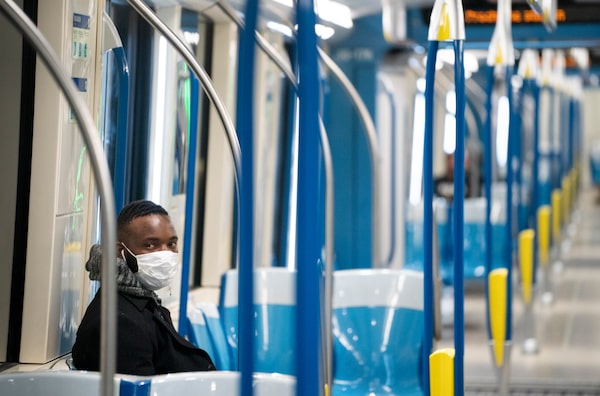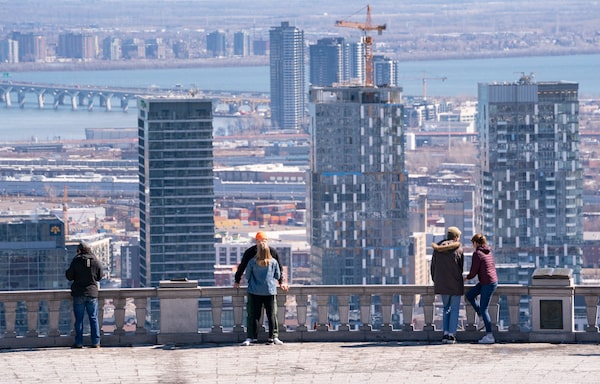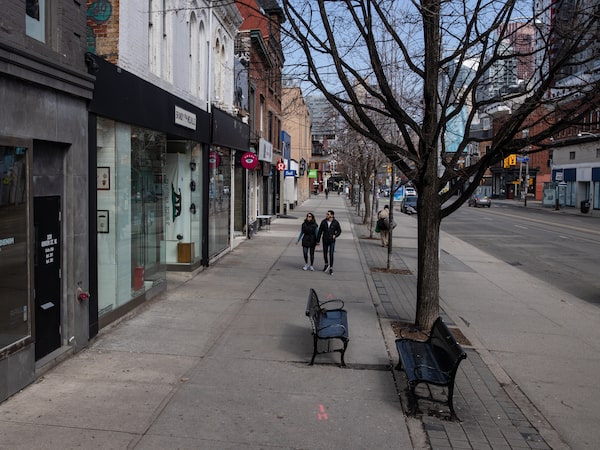
A lone commuter wearing a protective mask rides a near-empty subway in Montreal on March 24, 2020.Paul Chiasson/The Canadian Press
Richard Florida is a professor at the University of Toronto’s Rotman School of Management and School of Cities. His books include The Rise of the Creative Class and The New Urban Crisis.
As the coronavirus surges across Canada, the immediate response has been social distancing to damp down its spread. But our cities can’t stay locked-down indefinitely. The economic costs, never mind the toll it takes on our society, culture, and mental health, are too devastating. Sooner or later, they will need to reopen.
To do so will not be as easy as hitting a reset button that returns everything to normal in a month or two. This pandemic, like previous pandemics, will likely return in waves over the next six, 12 and 18 months, until therapies are put in place, a vaccine is developed or the virus burns itself out.
If we want to reopen safely and securely, we have to start preparing now. In addition to widespread testing, careful monitoring and more precisely targeted interventions, here is a short list of practical things we can start to do now to get our cities and economy back up and running safely and securely.
Coronavirus guide: Updates and essential resources about the COVID-19 pandemic
Take airports, for example. They will require a significant retrofit, considerably bigger than in the wake of the 9/11 terrorist attacks. Temperature checks and health screenings will likely be needed. Long lines, crowded waiting areas and chaotic baggage claims areas will have to be redesigned for social distancing. Some of this is as simple as painting lines or circles on the floor, DIY versions of which are already cropping up in grocery stories. Airport personnel and airline staff may need to wear masks and gloves. Hand sanitizer and, if needed, masks and gloves should be made widely available to passengers. Airlines may need to reduce their passenger counts and keep middle seats open. Similar kinds of retrofits will also be necessary in hockey arenas, football stadiums, convention centres, performing arts centres, universities, schools and indoor shopping malls, which pack a lot of people into confined spaces.

Coronavirus information signs are shown at an empty arrivals hall in Montreal–Trudeau International Airport on March 20, 2020.Graham Hughes/The Canadian Press
Buses, subways and train stations are petri dishes for contagion. To keep rush hour crowds at a minimum, workplaces will have to stagger their start and closing times. Passenger counts will need to be monitored and waiting areas retrofitted for social distancing.
During this crisis, we have all learned that we can be outside for walks or bike rides. Biking and walking will be our safest way to get to and from work. Bike lanes should be expanded, and bike and scooter sharing programs should be, too. Some cities are already pedestrianizing crowded streets to promote social distancing. It makes sense to keep such changes in place for the long haul.

People practise physical distancing as they look over Montreal from Mount Royal Park on March 27, 2020.Paul Chiasson/The Canadian Press
The small businesses – the restaurants and cafés, hair salons and barbershops, nail salons, gyms and fitness studios, bookstores and hardware stores – that lend our cities and neighbourhoods so much of their unique character, are mortally threatened by the crisis. So, too, is the cultural sector of art galleries, museums, music venues and smaller theatres, along with the artists, musicians and actors whose livelihoods depend on them. Imagine block after block in Toronto, Vancouver or Montreal marred by empty storefronts, devoid of arts and culture. In addition to mortgage, rent and tax relief, zero-interest loans and other forms of financial assistance, they will need technical assistance on what they will have to do to reopen and stay open safely.
The heroes of the battle against this virus are the front-line workers, the emergency responders, nurses’ aides, physicians’ assistants, transit workers, delivery workers, grocery store clerks and stockers, and cleaners. They need better pay, and access to the masks and protective gear required to keep them safe. But as we reopen, their protective equipment need not be makeshift DIY gear fashioned at home or the equivalent of a hazmat suit. Let’s mobilize Canadian fashion designers and clothing companies to provide personal protective gear that is functional and not so visually obtrusive.

Pedestrians walk along a near-empty Queen Street West in Toronto on March 25, 2020.Melissa Tait/The Globe and Mail
We cannot give up on density. The clustering of talented people in urban centres is the key driver of innovation and economic growth. This means leveraging its upside while protecting against its downsides. The virus has exposed a deep density divide: rich people density, where the advantaged can do remote work and order in delivery from their expensive homes, versus poor people density where the less advantaged are crammed together in multigenerational households who must head out on transit to work in crowded, exposed conditions. This density divide weakens all of us because vulnerable communities open all of us to the spread of the virus. A city cannot be safe if it is not equitable.
There is light at the end of the tunnel. No pandemic – not the plagues, not London’s cholera epidemic, not the devastating Spanish flu of the early 20th century – has killed off our great cities or quelled the force of urbanization. But our cities will not just pop back to normal in the next month or two. As we lock down our cities and mobilize to create the needed medical capacity to beat back the virus in the short run, we must operate on a parallel track to develop a plan to safely reopen our communities and reboot our economy.
Rome lay empty on Monday as a government-ordered shutdown to contain the spread of the coronavirus, under which all non-essential movements are banned and shops and parks are closed, continues.
The Associated Press
Sign up for the Coronavirus Update newsletter to read the day’s essential coronavirus news, features and explainers written by Globe reporters.